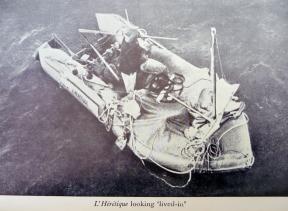Experts in the field of behavioral economics, Richard Thaler and Cass Sunstein in their book «Nudge. Architecture of Choice "talk about what lies behind our decisions. Layfhaker chose eight interesting facts about how we make choices.

Richard Thaler
The American economist, Nobel Prize in Economics in 2017 for his contribution to the field of behavioral economics.

Cass Sunstein
American scientist in the field of jurisprudence, is also engaged in behavioral economics. Author of "The Illusion of Choice" and one of the founders of the theory of pushing.
1. The mutual arrangement of options can influence the choice
As an example, the authors present location of dishes in school cafeterias. It turns out that if you put on eye-level students carrots instead of fries, you can push them to the choice of healthy food instead of fast food. With a similar technique of pushing we meet everywhere, starting with inscriptions on promotional banners and finishing departments sequence in a supermarket.
Also, the authors tell us that we tend to relate new answers to those we already know. In this case, the relative position of the issues also plays a role.
As an example the two questions posed by the students:
- How are you happy?
- How often do you go on dates?
When these questions were asked in such a manner was low correlation between them. But after they swapped, the correlation coefficient has increased almost six-fold. Many respondents thought: "Oh, do not even remember the last time I went out on a date! I should be very unhappy. "
2. Presumption of consent - is another effective way to influence our decisions
Paradoxically, but often we choose not more profitable option, but more simple, requiring the least amount of action.
That's why some magazines imply automatic renewal of the subscription, and this principle is the basis of the controversial Constitutional Court decision about organ transplants. Many agree to bequeath organs in need in the case of brain death, but not everyone decides to figure out how to do it, somewhere to go and something to sign. Therefore, in some cases, the presumption of consent is not a tool for profit, and effective way to make the world a better place.
3. Volume portions affects the amount of food eaten
This experiment confirms Brian Vansinga spent in one of Chicago cinemas. Visitors are free slipped a pack of stale tasteless popcorn. Some people received large bundles, and some - smaller portions. Naturally, such a treat no one liked, but the owners of large packs ate 53% more.
We have problems with self-discipline and tend to choose blindly. That is why we sometimes buy something that we do not need, we should only offer attractive discounts.
Vansing similar experiment conducted with the test, which was asked to have tomato soup Campbell as much as they want. Through the bottom portion of the special dishes are constantly replenished, but many people, even after eating his fill, continued thereWhile the researchers did not take pity on them.
4. Herd instinct exists and works
We tend to learn from others and to repeat them. The authors did not seek to educate the reader nonconformist, but simply explain how it works, and tell how to pay influence others in their favor.
You are going to lose weight? Dine with a more slender counterpart.
The authors also give an interesting example - share deal with waste on the highway in Texas. Traditional agitation perceived with hostility, then the authorities have turned to the power of society. They launched TV commercials with famous Texan players. Those on the screen collecting garbage crushes beer cans with his bare hands and growled: "You Do not Mess with Texas!" The rally was held successful: Now this slogan know 95% of Texans, and the amount of garbage on the sidelines since the start of the campaign decreased 72%.
5. Sounding choice carries more weight
Those who make up the polls, they want to classify the types of behavior, and not to influence him. But sociologists have discovered an unexpected fact: measuring the intentions of people can influence their behavior. If you ask people questions about their intentions, they are more likely to arrive in accordance with its answer.
Naturally, the choice of architects use this effect to their advantage. For example, the day before the election asking people if they are going to vote. A similar trick can increase turnout at 25%.
6. Context and "minor" attributes cause selection
People tend to give in to impulses caused by minor and seemingly irrelevant to the case attributes. For example, in the form of objects of the business environment, briefcases and desks for negotiations, people become more prone to competition, less interested in cooperation and less generous. A subtle scent of cleaning agent in the cafe will make people eat more accurately.
7. We tend to trust the subconscious signals more than the experience of
When Richard Thaler has taught at the School of Business, students often went early, even during classes. The only way out was through the large double doors, visible from anywhere in the audience. The flaps have large beautiful wood handles cylindrical shape about 60 cm in height.
If you are going to slip away, the students felt two opposing pulse. Handle yourself look so that they and wanted to pull over. But the door opened outward, and each of the students, no doubt, knew it. However, students and even the Thaler continued to fall into this trap, pulling by the handles before you commit to push.
This door - an example of a bad choice of architecture, where the nature of the signal does not match the desired effect. This contradiction we observe, if we represent the red hexagon with a white inscription "Forward."
8. Independent choice - it is not always good
The authors talk about the concept of libertarian paternalism - a compromise between freedom and lack of choice. Indeed, the artificial restriction of options serves the noble goals, and absolute permissiveness and diversity of choice can enter anyone astray.
As a simple example, the authors cite the original idea of employees Schiphol Airport in Amsterdam. They noticed that men rarely attach importance to labor cleaners not specifically take aim at Urinating in a urinal. Then, by the decision of the administration in each urinal painted the usual black fly. Accuracy visitors toilet has reached 80%.
Another common example architecture proper choice and limitations of options - the so-called foolproof, form factors mismatch plugs and sockets, not intended for contact with each other.
The authors divide the people on the "economy" and "humanity": the first is always rational, and do not make mistakes. The second impulsive, do selection based subconscious parcels and are not compatible with self-control.
Most of us in varying degrees, belongs to the second group, so choosing the right architecture built on pushing and limited options, help us, and does not seek to deceive or to anything force.
Paper bookElectronic book



